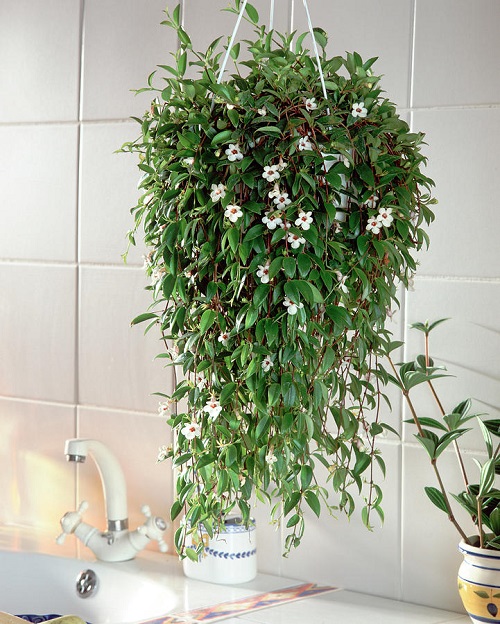Learn everything about growing Codonanthe Devosiana in simple steps and liven your home with its tropical elegance!

Embrace the exotic charm of Codonanthe devosiana as it graces your living space with its delicate blooms and lush foliage. Discover the art of growing this tropical plant and uncover the optimal conditions in this informative guide!
- Botanical Name: Codonanthe devosiana
- Popular as Bellflower
- Reaches upto 1-2 feet indoors
- Prefers bright indirect sunlight
- Thrives in a temperature range of around 68-77 F (20-25 C)
What is Codonanthe Devosiana?

Codonanthe Devosiana, a rare member of the Gesneriaceae family, showcases its unique charm through distinctive features. This tropical plant boasts graceful foliage with elliptical leaves, creating an elegant cascading effect. The plant’s appearance is characterized by its compact and trailing growth habit, making it an excellent choice for hanging baskets or elevated planters.
With vines reaching upto 1-2 feet, Bellflower is a modestly sized treasure. Adding to its allure, dainty and pendulous flowers in shades of white or pale pink emerge delicately from the foliage, enhancing its beauty.
This remarkable combination of foliage shape, compact growth, and charming blossoms makes Codonanthe Devosiana a captivating addition to indoor gardens and spaces.
Ideal Pot Size

The ideal Pot Size for Codonanthe Devosiana depends on the plant size. Generally, a pot that is 1 to 2 inches larger than the plant’s root ball works well for this species. Since Bellflowers typically grow to a height of 1-2 feet, a pot around 6 to 8 inches in diameter usually accommodates its growth comfortably.
As a general thumb rule, choose a container that provides ample space for the roots to grow but is not excessively large. A pot that is too large can lead to over-watering and root rot, while a pot that is too small can restrict growth and lead to under-watering. Always choose a pot with ample drainage holes.
Codonanthe Devosiana Propagation

Codonanthe devosiana can be easily propagated through several techniques, such as stem and leaf cutting. However, propagation via leaf cuttings is the easiest way to opt for:
- Choose healthy stems with a few leaves attached. These cuttings should ideally be around 4 to 6 inches in length.
- Trim the cutting just below a leaf node using sharp and clean pruning shears. This node is crucial for root development.
- Carefully remove the leaves from the lower part of the cutting, leaving a couple of leaves at the top intact.
- Let the cut end of the stem dry and callus over for a day or two. This minimizes the risk of rot when you plant it.
- Fill a small pot with well-draining soil, such as a mix of potting soil and perlite.
- Gently insert the dried end of the cutting into the soil, burying the node where the leaves were removed.
- Cover the pot with a plastic bag or a transparent dome to create a humid environment that encourages root growth.
- Position the pot in a bright, indirect light location and avoid direct sunlight. Water lightly when the top inch of soil feels dry.
You should see signs of root growth in a few weeks to a couple of months. Gently tug on the cutting to feel resistance, indicating that roots have developed. Once roots are well-established, transplant the cutting into a slightly larger pot with regular soil and take good care of your plant.
Codonanthe Devosiana Care

Light
Expose your Bellflower plant with 6-8 hours of bright, indirect sunlight to foster growth, as direct rays could scorch the leaves. A spot near an east or north-facing window will fulfill its sunlight requirement perfectly. Morning sunlight from an east-facing window can be particularly beneficial to nourish its glossy foliage and healthy vine growth.
You can supplement your space with fluorescent or LED grow lights if it lacks sufficient natural light. Position the lights about 12 to 18 inches above the plant, and keep them on for approximately 12 hours daily to mimic natural sunlight.
Soil
Codonanthe devosiana requires specific soil care for healthy growth, including a slightly acidic to neutral pH range of 6-7. For optimal drainage and to imitate its natural habitat, blend 1 part perlite and 1 part peat moss with every 2 parts of the standard soil mix. Incorporating a small quantity of well-composted organic matter can also enhance nutrition.
It might be tempting to use garden soil, but it’s often too dense for plants like Codonanthe devosiana. Stick with a quality potting mix and the amendments mentioned. Ensure the soil doesn’t become compacted, which can hinder root growth. Fluffing the soil lightly on occasion can help.
Water
Watering Codonanthe Devosiana, especially when kept as an indoor plant, requires careful attention to maintain its health. Ensure to keep the soil consistently moist but not soggy. As with most houseplants, overwatering can lead to root rot, while underwatering will cause the leaves to wilt and dry.
To achieve the perfect balance, water the plant when the top inch of soil feels dry to the touch, usually once a week in its growing season, depending on indoor conditions. Reduce watering in the dormant winter season, waiting until the top few inches are dry, and adjust according to humidity levels.
Pro Tip: Watering directly into the soil rather than over the leaves can prevent fungal issues.
Temperature and Humidity
Codonanthe devosiana‘s success relies on carefully controlled temperature and humidity levels. A household temperature range of 68-77 F (20-25 C) during the day, slightly cooler at night, will provide a suitable environment for the plant. However, temperatures below 40 F or 5 C can be fatal, so keep heat lamps or indoor greenhouses handy to provide the needed warmth.
Also, keep it away from drafty windows or heating vents to avoid sudden temperature fluctuations and unwanted plant stress.
Humidity levels of 50-60% could greatly benefit your plant. Placing a tray filled with water and pebbles beneath the pot can help maintain humidity. Just ensure that the pot doesn’t sit directly in the water. In drier climates, using a room humidifier can also be beneficial.
Fertilizers
Look for a balanced liquid houseplant fertilizer with equal parts N-P-K, such as a 10-10-10 or 20-20-20 formula. If you prefer organic care, consider using worm castings or fish emulsion, which provide a gentle nutrient boost. Follow the instructions on the packaging, but generally, a half-strength dilution is suitable for this plant.
Fertilize every 4 to 6 weeks during the growing season, typically spring through early fall. Reduce fertilization during the dormant or winter months to once every 8 to 12 weeks, or even withhold completely if the plant is in full dormancy.
Pro Tip: Always water the plant slightly before fertilizing to prevent the fertilizer from shocking the roots.
Pruning
Pruning is essential to maintaining the health and appearance of Codonanthe Devosiana. The growing season is the ideal time to prune, as the plant produces new growth. During dormancy, the plant rests, and pruning can cause undue stress. Always use a pair of sharp pruning shears or scissors that have been cleaned with rubbing alcohol to prevent disease transmission.
Start by removing dead or damaged leaves and stems to promote healthy growth. If you wish to shape the plant, trim it back to a leaf node. If you want a bushier plant, pinch off the tips at the onset of the growing season.
Pro Tip: If your Codonanthe Devosiana has bloomed, wait until the flowers have faded before pruning so you don’t accidentally cut off future blossoms. Also, remove no more than one-third of the plant at a time to avoid stressing it.
Major Troubleshooting Tips
- Yellowing Leaves: Often caused by overwatering, lack of nutrients, or insufficient light; remedy by adjusting watering, considering fertilization, or relocating for proper lighting.
- Brown Leaf Tips: Indicative of low humidity or over-fertilization; increase humidity with a tray or humidifier and ensure proper fertilizer dilution.
- Drooping or Wilting: Result of under watering or root rot; assess and adjust watering, or repot if root rot is suspected.
- Loss of Leaves: Caused by temperature fluctuations or poor air circulation; move away from drafts and vents.
- Pests (Such as Spider Mites or Aphids): Due to poor air circulation or overwatering, increase air circulation, reduce watering if soggy, and treat with insecticidal soap or neem oil.
- Failure to Flower: A sign of insufficient light or incorrect fertilization; relocate to a brighter spot and consider a balanced fertilizer.
- Leggy Growth: Caused by lack of sunlight; move to a spot with more appropriate lighting or use a grow light.
Where To Buy Codonanthe Devosiana?

Finding a Codonanthe Devosiana for your collection can be an exciting venture. You can get Codonanthe Devosiana For Sale on online platforms such as Amazon and Etsy. Visit or call nearby nurseries and garden centers; they may carry this plant or order it for you. Participate in local plant swap events or online plant trading communities where enthusiasts share cuttings and plants.
If you know other plant enthusiasts, especially those interested in exotic species, they might be able to guide you to a source or share a cutting. Always look for reputed sites and analyze the reviews to ensure a good quality houseplant.






